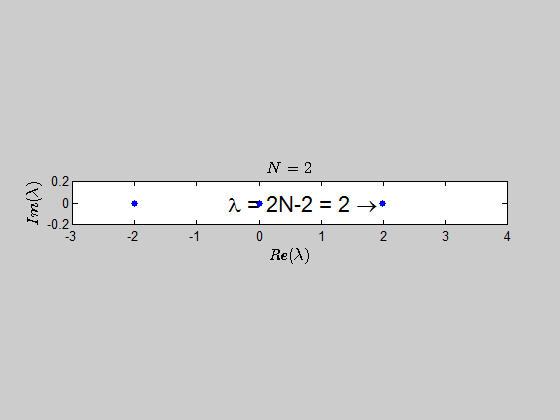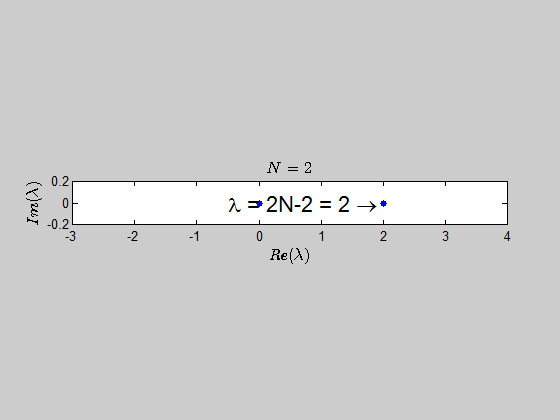I will answer your question just for the cases $N = 2$ and $N = 3$:
Let
$$ B_2 = \left(
\begin{array}{cccc}
0 & 1 & 1 & 0 \\
1 & 0 & 0 & 1 \\
1 & 0 & 0 & 1 \\
0 & 1 & 1 & 0
\end{array}
\right), \quad B_3 = \left(
\begin{array}{cccccc}
0 & 1 & 1 & 1 & 1 & 0 \\
1 & 0 & 1 & 1 & 0 & 1 \\
1 & 1 & 0 & 0 & 1 & 1 \\
1 & 1 & 0 & 0 & 1 & 1 \\
1 & 0 & 1 & 1 & 0 & 1 \\
0 & 1 & 1 & 1 & 1 & 0
\end{array}
\right), $$
then, $\text{Spec}{(B_2)} = {(-2,2,0,0)} \, $ and $\text{Spec}{(B_3)} = (-2,-2,0,0,0,4). $
With the help of numerics, I've been able to show (at least for sufficiently large values of $N$) that the characteristic polynomial is given by:
$$\color{blue}{p(\lambda) =\det{(B_N - \lambda I_{2N})} = (\lambda - 2N +2)(\lambda+2)^{N-1} \lambda^N }$$
which tells you that the only eigenvalues of this kind of matrices are $-2,0,2N-2 \ $ with the corresponding multiplicities given by $p(\lambda)$.
Here is an animation showing the spectrum of the matrices $B_N$ for $N \in (2,30)$:

Here's the same approach in the case we have the $B_N$ matrices defined as:
$$B_N = \begin{bmatrix} C_N & A_N \\ A_N & C_N \end{bmatrix},$$
then:
$$\color{blue}{p(\lambda) =\det{(B_N - \lambda I_{2N})} = \left\{ \begin{array}{ll}
\left(\lambda - 2N + 2\right) (\lambda-2)^{N/2}(\lambda+2)^{(N-2)/2} \lambda^{N} & N \text{ even} \\
\left(\lambda - 2N + 2\right) (\lambda-2)^{(N-1)/2}(\lambda+2)^{(N-1)/2} \lambda^{N} & N \text{ odd}
\end{array}\right.}$$
which tells you that the only eigenvalues of this kind of matrices are $-2,0,2,2N-2 \ $ with the corresponding multiplicities given by $p(\lambda)$.
Here is another animation showing the spectrum of the matrices $B_N$ for $N \in (2,30)$:

pretty cool!
Hope somebody can shed some light on these results.
Cheers!
Here is a partial answer. Let us consider the case where the number of block rows is $n=4$ first. The other cases are similar. We shall perform blockwise elementary row/column operations on the block matrix
$$
\pmatrix{
I&Q&Q&Q\\
Q^T&I&Q&Q\\
Q^T&Q^T&I&Q\\
Q^T&Q^T&Q^T&I}.
$$
First, for $i=n,n-1,\ldots$ down to $2$, subtract the $i$-th block row by the one above it. We get
$$
\pmatrix{
I&Q&Q&Q\\
Q^T-I&I-Q&0&0\\
0&Q^T-I&I-Q&0\\
0&0&Q^T-I&I-Q}.
$$
Suppose $1$ is not an eigenvalue of $Q$. Let
$$
M=(I-Q)^{-1}(Q^T-I).
$$
Then for $j=n-1,n-2,\ldots$ down to $1$, perform the block column operation $C_j\leftarrow C_j-C_{j+1}M$ successively. When $n=4$, we will obtain, in three steps, the following matrices:
\begin{aligned}
&\pmatrix{
I&Q&Q-QM&Q\\
Q^T-I&I-Q&0&0\\
0&Q^T-I&I-Q&0\\
0&0&0&I-Q},\\
&\pmatrix{
I&Q-QM+QM^2&Q-QM&Q\\
Q^T-I&I-Q&0&0\\
0&0&I-Q&0\\
0&0&0&I-Q},\\
&\pmatrix{
I-QM+QM^2-QM^3&Q-QM+QM^2&Q-QM&Q\\
0&I-Q&0&0\\
0&0&I-Q&0\\
0&0&0&I-Q}.
\end{aligned}
Hence at the end we get a block upper triangular matrix. In general, if $1$ is not an eigenvalue of $Q$, the determinant of the original block matrix is given by
$$
\det\left(I+Q\left[(-M)+(-M)^2+..+(-M)^{n-1}\right]\right)\det(I-Q)^{n-1}.\tag{1}
$$
Here we do not replace the square bracket term by $[(-M)-(-M)^n](I+M)^{-1}$ because $-1$ may be an eigenvalue of $M$ (in particular, this always occurs if the size $N$ of the matrix $Q$ is odd).
Since the determinant of the original block matrix is a polynomial in the entries of $Q$, if a generic formula exists, we don't expect it to contain any matrix inverse term. Unfortunately I cannot manage to cancel out the inverse term $(I-Q)^{-1}$ inside the powers of $M$. Therefore formula $(1)$ cannot be further simplified at the moment and the requirement that $1$ is not an eigenvalue of $Q$ cannot be dropped yet.


Best Answer
Here is an approach using the fact that $B^{-1}$ exists. Note that $$ C = (I_m \otimes B)(I_m \otimes (B^{-1}A - I) + J_m \otimes I_n), $$ where $\otimes$ denotes the Kronecker product, $I_k$ denotes the identity matrix of size $k$, and $J_m$ is the size $m$ matrix whose entries are all equal to $1$. We note that $$ C^{-1} = (I_m \otimes (B^{-1}A - I) + J_m \otimes I_n)^{-1}(I_m \otimes B)^{-1} \\ = (I_m \otimes M + J_m \otimes I_n)^{-1}(I_m \otimes B^{-1}), $$ where $M = B^{-1}A - I$. Let $e \in \Bbb R^m$ denote the column-vector whose entries are all $1$; note that $J_m = ee^T$. If $M$ and $M + mI$ are invertible, then with the Woodbury matrix identity we can write $$ \begin{align} (I_m \otimes M + J_m \otimes I_n)^{-1} & = (I_m \otimes M + (e \otimes I_n)(e \otimes I_n)^T)^{-1} \\ & = (I_m \otimes M)^{-1} - (I_m \otimes M)^{-1}(e \otimes I_n)( \\ & \quad \qquad I_{n} + (e \otimes I_n)^T(I_m \otimes M)^{-1}(e \otimes I_n) \\ & \quad )^{-1}(e \otimes I_n)^T(I \otimes M)^{-1} \\ & = (I_m \otimes M^{-1}) - (I_m \otimes M^{-1})(e \otimes I_n) \\ & \quad \qquad \cdot(I_{n} + (e^Te \otimes M^{-1}))^{-1}(e \otimes I_n)^T(I \otimes M^{-1}) \\ & = (I_m \otimes M^{-1}) - (e \otimes M^{-1})(I_{n} + m \cdot M^{-1})^{-1}(e^T \otimes M^{-1}). \end{align} $$ We can simplify this a bit further: note that the second term can be reduced as follows. $$ (e \otimes M^{-1})(I_{n} + m \cdot M^{-1})^{-1}(e^T \otimes M^{-1}) = \\ (e \otimes M^{-1})M(M + m I_n)^{-1}(e^T \otimes M^{-1}) = \\ (e \otimes I_n)(M + mI_n)^{-1}(e^T \otimes M^{-1}) = \\ (e \otimes (M + mI_n)^{-1})(e^T \otimes M^{-1}) = \\ (ee^T) \otimes [(M + mI_n)^{-1}M^{-1}] = \\ J_m \otimes (M^2 + m\cdot M)^{-1}. $$ Putting this all together, we get $$ C^{-1} = (I_m \otimes M + J_m \otimes I_n)^{-1}(I_m \otimes B^{-1})\\ = (I_m \otimes M^{-1} - J_m \otimes (M^2 + m\cdot M)^{-1})(I_m \otimes B^{-1}) \\ = I_m \otimes (M^{-1}B^{-1}) - J_m \otimes ((M^2 + m\cdot M)^{-1}B^{-1}) \\ = I_m \otimes (A - B)^{-1} - J_m \otimes (B(B^{-1}A - I)^2 + m \cdot (A - B))^{-1}. $$ Because this expression is in the form $I_m \otimes P + J_m \otimes Q$, we can see that $C^{-1}$ will indeed have the same block-structure as $C$.